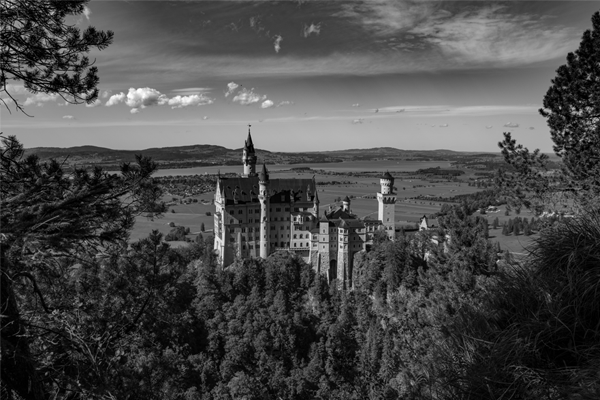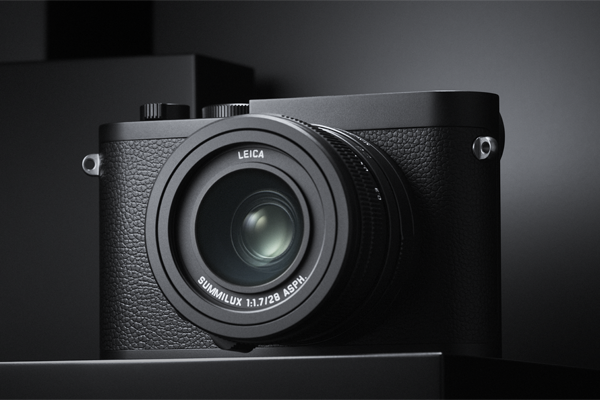Today Leica announced the release of the Q2 Monochrom, their latest black & white camera. Following the M10 Monochrom, the Q2 Monochrom is the second monochrome camera Leica has released this year. As you may have guessed, the new camera is also closely related to the Leica Q2. We decided to compare all three cameras (Leica Q2 vs Q2 Monochrom vs M10 Monochrom) to help prospective customers determine exactly which Leica model is right for them.
Sensor

All three cameras have high resolution, full frame CMOS sensors. The Leica M10 Monochrom has a 40MP sensor, while the Q2 and Q2 Monochrom have a 47.3MP sensor. However, the sensors on the Q2 Monochrom and M10 Monochrom cameras are also monochrome. This enables them to produce imagery at an even higher resolution, albeit only in black and white.
Let’s quickly explain why that’s the case. Camera sensors create color in photographs using a color filter array (CFA). Most sensors use a Bayer CFA, a grid of alternating red, green, and blue pixels, to add color to your image. As a result, each pixel in the resulting photograph is only capturing one-third of the light because each pixel can only replicate its specific color (a red pixel can’t display blue light). Monochrome sensors don’t use a CFA, allowing them to capture light in every pixel and produce more detailed imagery.
The additional light and detail in imagery generated by a monochrome sensor equates to a small increase in resolution. That means the Q2 Monochrom technically produces imagery closer in resolution to the 64MP Leica S3 than the Q2. The M10 Monochrom produces imagery at about the same resolution as the Q2.
Build

The Q2 and Q2 Monochrom share the same small, lightweight build. They weigh 734g (25.3 oz) when fitted with a battery, and have a fixed Summilux 28mm f/1.7 ASPH. lens. The sensor is the key distinguishing factor between them. Leica describes the Q2 Monochrom as the first, full frame compact camera ever to be made with a dedicated monochrome sensor.
The M10 Monochrom weighs 660g (23.3 oz) with a battery. However, it’s not a fixed lens system. Once fitted with a lens, it weighs more than the Q2 and Q2 Monochrom. The camera is compatible with M Lenses, and R lenses with an adapter.
All three cameras have a magnesium frame with a stylish matte black finish, although only the Q2 and Q2 Monochrom have weather sealing. Additionally, only the Q2 wears Leica’s signature red logo on its front. Like the M10 Monochrom, the Q2 Monochrom omits color, using gray, white, and black fill for all engravings.
Performance
As mentioned, all three cameras can produce high resolution imagery and can work well in low-light. The monochrome cameras have a small advantage, capable of reaching a higher ISO (100,000) without generating too much noise.
While the fixed 28mm lens on the Q2 and Q2 Monochrom cameras has some restrictions, its wide max aperture (f/1.7) and digital zoom capabilities mean it can handle most styles of photography. While either one will be the most expensive point-and-shoot camera you’ll ever buy, that’s not to say you aren’t getting value. It’s an optimistic view, but it can be refreshing not to have to carry around extra lenses, or worry if you’re using the right one. The versatility of the fixed lens means you can capture great photos in most settings. Plus, like their cameras, Leica lenses are extremely high-end, so you’ll save money in the long run. If you don’t want to limit yourself to a single lens, however, the M10 Monochrom is the easy choice.
It’s important to mention that the M10 Monochrom is strictly for manual photographers. The camera has no autofocus nor video capabilities. Both the Q2 and Q2 Monochrom, however, can output 4K video and have fast, accurate autofocus, including tracking and face detection functionality. Additionally, they have a continuous shooting rate of 10fps. The M10 Monochrom maxes out at 4.5fps.
While the price tags on all three cameras may scare away some customers, you can’t deny their performance potential. Despite their simple, elegant design, all three cameras have the capacity to output outstanding visuals. Leica has mastered the art of simplifying functionality to benefit their customers, ensuring you never feel like you’re paying more for less.
Leica Q2 vs Q2 Monochrom vs M10 Monochrom Spec Comparison
Comparing the specs side-by-side helps clarify the differences between the three cameras.
| Leica Q2 | Leica Q2 Monochrom | Leica M10 Monochrom | |
|---|---|---|---|
| Sensor | 47.3MP Full Frame CMOS Sensor | 47.3MP Monochrome Full Frame CMOS Sensor | 40MP Monochrome Full Frame CMOS Sensor |
| ISO | 50 - 50,000 | 100 - 100,000 | 160 - 100,000 |
| Lens Compatibility | Fixed Lens - Leica Summilux 28 f/1.7 ASPH., 11 elements in 9 groups, 3 aspherical elements | Fixed Lens - Leica Summilux 28 f/1.7 ASPH., 11 elements in 9 groups, 3 aspherical elements | Compatible with Leica M Lenses, R Lenses with Adapter |
| Memory Card Slots | 1 | 1 | 1 |
| Storage Type | SD/SDHC/SDXC memory cards. Recommendation: UHS II memory cards | SD/SDHC/SDXC memory cards. Recommendation: UHS II memory cards | SD cards up to 2GB/SDHC cards up to 32GB/SDXC cards up to 2TB |
| Continuous Shooting | Selectable: 10/5/3 fps (H/M/L) | Selectable: 10/5/3 fps (H/M/L) | Approx. 4.5 pictures/s |
| Viewfinder | 3.68MP OLED Electronic Viewfinder | 3.68MP OLED Electronic Viewfinder | Bright-line Optical Viewfinder |
| 4K Video | Yes | Yes | No |
| Battery Life (CIPA-Standard) | 350 shots | 350 shots | No Rating |
| Built-In Wi-Fi & FOTOS App Compatibility | Yes | Yes | Yes |
| Weather Sealing | IP52 Protective Sealing Against Dust and Spraywater | IP52 Protective Sealing Against Dust and Spraywater | No |
| Dimensions (W x H x D) | 130 x 80 x 91.9 mm | 130 x 80 x 91.9 mm | 139 x 38.5 x 80 mm |
| Weight (with battery) | 734g (25.3 oz) | 734g (25.3 oz) | 660g (23.3 oz) |
| Price | $4,995 | $5,995 | $8,295 |
Verdict
Comparing the Leica Q2 vs Q2 Monochrom vs M10 Monochrom, it’s clear there’s something to love about all three cameras.
The Q2 Monochrom and M10 Monochrom will excite any photographer who is passionate about shooting in black and white. The Q2 Monochrom can produce dazzlingly high resolution photos and video, while the M10 Monochrom is compatible with multiple lenses. However if you’re not committed to always shooting in black & white, the Q2 offers many of the same features as both cameras and a lower price tag. Whatever your personal preference, you won’t be disappointed.










If you use the Q2 in monochrome mode to create b & w images, vs the Q2 monochrome jpg, is there much benefit in buying the Q2M?
I enjoy b & w but on occasion it is nice to have color. I own the Sony A7iii as well as M240 and 28 and 90mm cron lenses.
Thoughts?
Hi Barry. There’s a very slight difference in quality. While the Q2 and the Q2 Monochrom effectively have the same sensor, the lack of a color filter array on the Q2 Monochrom sensor means it captures every pixel in your frame, translating to a slightly more detailed image. The downside is, you can only take B&W photos, as without the CFA it can’t produce color. It’s worth noting that even with a CFA, the sensor on the Q2 is incredibly high resolution and will capture beautiful imagery. By no means will you take photos with the Q2 and think ‘hmm, these could be more detailed.’ It’s a great quality camera. However, you also already own an a7 III, so maybe you want the Q2 Monochrom just for the novelty of having a full-frame digital camera that’s exclusively black and white. I also want to point out out that both the Q2 and Q2 Monochrom cameras have a fixed lens, so you won’t be able to use other lenses on them. I hope this helps!
The weight comparisons are misleading. Both Q camera weights include the fixed lens, while the M10 is body only. With a comparable lens, the M10 will be much heavier.
Hi Steve, thanks for your comment. You’re 100% right, I forgot to account for the fixed lens. Once you put a lens on the M10, it’s heavier than both Q2 cameras. I’ve updated the post!